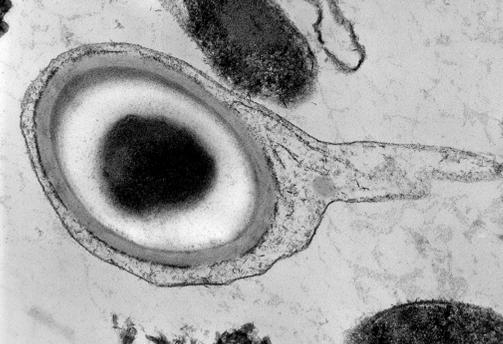Carboxydothermus hydrogenoformans
A Microbial Biorealm page on the genus Carboxydothermus hydrogenoformans
Classification
Higher order taxa
Domain: Bacteria
Phylum: Firmicutes
Class: Clostridia
Order: Clostridiales
Family: Peptococcaceae
Species
Carboxydothermus hydrogenoformans
Description and significance
C. hydrogenoformans are aquatic bacteria that live in freshwater environments and experience optimal growth at temperatures around seventy degrees celcius. This bacterium is unique and important because it lives at very high temperatures (thermophile), grows very rapidly in high carbon monoxide aquatic environments, lives entirely off of carbon monoxide and also converts water to hydrogen through the oxidation of carbon monoxide to form carbon dioxide. The formation of hydrogen is very important because hydrogen is considered to be a potential biofuel in the near future. [1]
The bacterium was first isolated from freshwater hot springs on the volcanic Russian island of Kunashir. [2]
Genome structure
The genome of C. hydrogenoformans has been fully sequenced. This organism has a single circular chromosome that consists of 2,401,892 base pairs. This bacterium also contains between 2600 to 2700 protein coding genes. [1]
C. hydrogenoformans is very unique in that it has genes that code for five distinct and different carbon monoxide dehydrogenase complexes. This compared to one complex found on similar bacteria that grow in carbon monoxide environments may be the reason why C. hydrogenoformans grows so much more rapidly and efficiently. [1]
Furthermore, the sequencing and analysis of the bacteria's genome has shown it to include genes for producing spores. Yet C. hydrogenoformans appears to lack many genes for spore production that other bacteria contain, which means that this bacterium could serve as a model for the study of minimal sporulation. [1]
C. hydrogenformans has no plasmids.
 An electron micrograph of a C. hydrogenoformans endospore.
An electron micrograph of a C. hydrogenoformans endospore.
Source: Wu M, Ren Q, Durkin AS, Daugherty SC, Brinkac LM, et al. (2005) Life in Hot Carbon Monoxide: The Complete Genome Sequence of Carboxydothermus hydrogenoformans Z-2901. PLoS Genet 1(5): e65
Cell structure and metabolism
C. hydrogenoformans is a gram-positive bacterium that has flagella and can produce endospores. [1]
It has five carbon monoxide dehydrogenase complexes. One is used in energy conservation, another in oxidative stress response, while another takes part in carbon fixation. Unlike most organisms that use a carbon dioxide fixation pathway, C. hydrogenoformans instead utilizes a carbon monoxide fixation pathway. [1]
The CODH complex (CODH-I) notably responsible for energy conservation contains a membrane bound complex that oxidizes carbon monoxide to carbon dioxide. This process also pumps protons across the membrane, creating a proton gradient that is utilized to generate ATP; energy. Carbon fixation is attributed to CODH III, which has a key enzyme (CODH/acetyl-CoA synthase complex) that condenses carbon monoxide into acetyl-CoA. Acetyl-CoA can produce more ATP or be used in other biosynthetic pathways. CODH-IV plays an important role in oxidative stress response while CODH-II is thought to generate NADPH. [1]
C. hydrogenoformans also produces endospores due to stressful situations (DNA damage, low ATP levels, cell density). This discovery is important because this organism could serve as a model for studying the minimal biochemical machinery required to produce endospores. [1]
Ecology
There is little documentation on the interactions this organism has with other organisms, but C. hydrogenoformans converts poisonous carbon monoxide to carbon dioxide while producing hydrogen as well. So a possible contribution to the environment is production of a non-toxic carbon source as well as hydrogen gas. [1]
Pathology
C. hydrogenoformans doesn’t cause any diseases. It only exists in extreme conditions such as freshwater hydrothermal vents. It actually plays a role in detoxification by converting carbon monoxide into carbon dioxide. [1]
Application to Biotechnology
C. hydrogenoformans has a lot of potential in the future due to it producing hydrogen gas from toxic carbon monoxide. This organism also does this rapidly and efficiently. Hydrogen gas is thought to be a potential biofuel in the future.
Current Research
The interaction of carbon monoxide with the active site on CODH II of C. hydrogenoformans is being studied through observing the effects of potassium cyanide, an inhibitor with respect to carbon monoxide, using X-ray absorption spectroscopy. [3]
The reduction of biological sulfate with carbon monoxide as it relates to different sulfate reducing thermophiles living in a pure culture or co-culture with C. hydrogenoformans is currently being studied as well. [8]
The structural changes necessary for the carbon monoxide-sensor of C. hydrogenoformans to activate and cause carbon monoxide metabolism to begin is being studied by observing crystal structures of the organism when bound to a ligand, namely imidazole. [4]
The structure and mechanism of CooA, a carbon monoxide detecting transcription factor of C. hydrogenoformans, is being studied and elucidated through X-ray analysis. [5],[7]
References
Edited by David Chung; student of Rachel Larsen and Kit Pogliano
